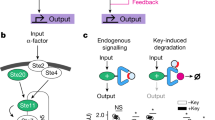Abstract
Synthetic biology has been advancing cellular and molecular biology studies through the design of synthetic circuits capable to examine diverse endogenously or exogenously driven regulatory pathways. While early genetic devices were engineered to be insulated from intracellular crosstalk, more recently the need of achieving dynamic control of cellular behavior has led to the development of smart interfaces that connect signal information (sensor) to desired output activation (actuator). Sensor-actuator circuits can respond to diverse inputs, including small molecules, exogenous and endogenous mRNA, noncoding RNA (i.e., miRNA), and proteins to regulate downstream events, transcriptionally, posttranscriptionally, and translationally. These devices require attentive engineering to either create complex chimeric proteins or modify protein structures to be amenable to the specific circuits’ architecture and/or purpose.
In this chapter, we describe how to implement two different protein-based devices in mammalian cells: (1) a modular platform that sense and respond to disease-associated proteins and (2) a protein-based system that allows simultaneous regulation of RNA translation and protein activity, via RNA-protein and newly engineered protein–protein interactions.
Access this chapter
Tax calculation will be finalised at checkout
Purchases are for personal use only
Similar content being viewed by others
References
Ausländer D, Eggerschwiler B, Kemmer C, Geering B, Ausländer S, Fussenegger M (2014) A designer cell-based histamine-specific human allergy profiler. Nat Commun 5:4408
di Bernardo D, Marucci L, Menolascina F, Siciliano V (2012) Predicting synthetic gene networks. Methods Mol Biol 813:57–81
Tigges M, Marquez-Lago TT, Stelling J, Fussenegger M (2009) A tunable synthetic mammalian oscillator. Nature 457:309–312
Siciliano V, Garzilli I, Fracassi C, Criscuolo S, Ventre S, di Bernardo D (2013) MiRNAs confer phenotypic robustness to gene networks by suppressing biological noise. Nat Commun 4:2364
Kipniss NH, Dingal PCDP, Abbott TR, Gao Y, Wang H, Dominguez AA, Labanieh L, Qi LS (2017) Engineering cell sensing and responses using a GPCR-coupled CRISPR-Cas system. Nat Commun 8:2212
Siciliano V, DiAndreth B, Monel B, Beal J, Huh J, Clayton KL, Wroblewska L, McKeon A, Walker BD, Weiss R (2018) Engineering modular intracellular protein sensor-actuator devices. Nat Commun 9:1881
Scheller L, Strittmatter T, Fuchs D, Bojar D, Fussenegger M (2018) Generalized extracellular molecule sensor platform for programming cellular behavior. Nat Chem Biol 14:723–729
Courbet A, Endy D, Renard E, Molina F, Bonnet J (2015) Detection of pathological biomarkers in human clinical samples via amplifying genetic switches and logic gates. Sci Transl Med 7:289ra83
Sedlmayer F, Fussenegger M (2017) Synthetic biology: a probiotic probe for inflammation. Nat Biomed Eng 1:0097
Schwarz KA, Daringer NM, Dolberg TB, Leonard JN (2016) Rewiring human cellular input–output using modular extracellular sensors. Nat Chem Biol 13:202
McNamara MA, Nair SK, Holl EK (2015) RNA-based vaccines in cancer immunotherapy. J Immunol Res 2015:794528
Sahin U, Karikó K, Türeci Ö (2014) mRNA-based therapeutics — developing a new class of drugs. Nat Rev Drug Discov 13:759–780
Cella F, Wroblewska L, Weiss R, Siciliano V (2018) Engineering protein-protein devices for multilayered regulation of mRNA translation using orthogonal proteases in mammalian cells. Nat Commun 9:1–9
Culler SJ, Hoff KG, Smolke CD (2010) Reprogramming cellular behavior with RNA controllers responsive to endogenous proteins. Science 330:1251–1255
Wroblewska L, Kitada T, Endo K, Siciliano V, Stillo B, Saito H, Weiss R (2015) Mammalian synthetic circuits with RNA binding proteins for RNA-only delivery. Nat Biotechnol 33:839–841
PyMOL | pymol.org. https://pymol.org/2/. Accessed 30 Oct 2019
Waterhouse A, Bertoni M, Bienert S, Studer G, Tauriello G, Gumienny R, Heer FT, de Beer TAP, Rempfer C, Bordoli L, Lepore R, Schwede T (2018) SWISS-MODEL: homology modelling of protein structures and complexes. Nucleic Acids Res 46:W296–W303
Engler C, Marillonnet S (2014) Golden Gate cloning. Methods Mol Biol 1116:119–131
Beal J, Wagner TE, Kitada T, Azizgolshani O, Parker JM, Densmore D, Weiss R (2015) Model-driven engineering of gene expression from RNA replicons. ACS Synth Biol 4:48–56
Beal J, Weiss R, Yaman F, Davidsohn N, Adler A (2012) A method for fast, high-precision characterization of synthetic biology devices. MIT CSAIL Tech Report 2012-008
Moore T, Zhang Y, Fenley MO, Li H (2004) Molecular basis of box C/D RNA-protein interactions; cocrystal structure of archaeal L7Ae and a box C/D RNA. Structure 12:807–818
Caliendo F, Dukhinova M, Siciliano V (2019) Engineered Cell-Based Therapeutics: Synthetic Biology Meets Immunology. Front. Bioeng. Biotechnol. 7:43
Cella F, Siciliano V (2019) Protein-based parts and devices that respond to intracellular and extracellular signals in mammalian cells. Curr. Opin. Chem. Biol. 52:47–53
Author information
Authors and Affiliations
Corresponding author
Editor information
Editors and Affiliations
Rights and permissions
Copyright information
© 2021 Springer Science+Business Media, LLC, part of Springer Nature
About this protocol
Cite this protocol
Bonfá, G., Cella, F., Siciliano, V. (2021). Engineering Protein-Based Parts for Genetic Devices in Mammalian Cells. In: Menolascina, F. (eds) Synthetic Gene Circuits . Methods in Molecular Biology, vol 2229. Humana, New York, NY. https://doi.org/10.1007/978-1-0716-1032-9_16
Download citation
DOI: https://doi.org/10.1007/978-1-0716-1032-9_16
Published:
Publisher Name: Humana, New York, NY
Print ISBN: 978-1-0716-1031-2
Online ISBN: 978-1-0716-1032-9
eBook Packages: Springer Protocols




